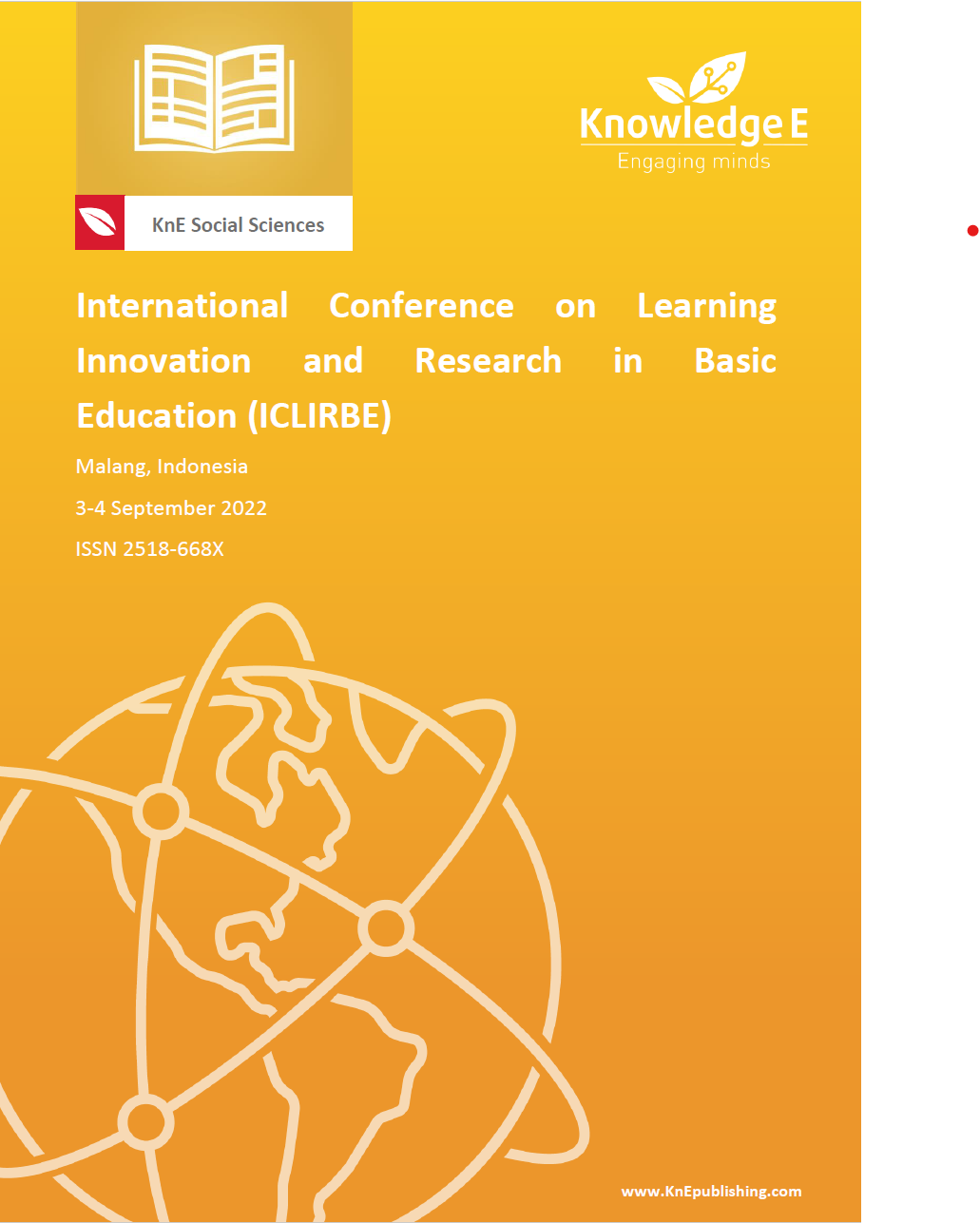Financial Literacy Learning Strategies in Elementary Schools
DOI:
https://doi.org/10.18502/kss.v8i8.13295Abstract
The scope of social studies in elementary schools includes the study of social sciences and also the life of the community. Several previous studies revealed the low-financial literacy of elementary school students. The purpose of this paper is to identify financial literacy learning strategies implemented by elementary school teachers around the world. The research method used is a literature study. The characteristics of sources used in this study are national and international articles from the last 10 years with the keywords financial literacy, elementary school, and learning. The results showed that three strategies could be applied in financial literacy to elementary schools, namely the strategy of preparing relevant teaching materials, making financial literacy questions, and innovative learning media.
Keywords: financial literacy, learning strategies, elementary schools
References
[2] C. Aprea et al., “International handbook of financial literacy,” Int. Handb. Financ. Lit., pp. 1–713, 2016, doi: 10.1007/978-981-10-0360-8.
[3] V. Laila, S. Hadi, and Subanji, “Pelaksanaan Pendidikan Literasi Finansial pada Siswa Sekolah Dasar,” J. Pendidik. Teor. Penelitian, dan Pengemb., vol. 4, no. 11, pp. 1491– 1495, 2019.
[4] R. W. Maulana and K. Kurniasih, “Pengembangan Bahan Ajar untuk Meningkatkan Kemampuan Literasi Finansial Siswa SD,” J. Pedagog. Pendidik. Dasar, vol. 8, no. 2, pp. 102–108, 2021, [Online]. Available: https://ejournal.upi.edu/index.php/jppd/article/view/40532
[5] N. Fabris and R. Luburic, “Financial education of children and youth,” J. Cent. Bank. Theory Pract., vol. 5, no. 2, pp. 65–79, 2016, doi: 10.1515/jcbtp-2016-0011.
[6] A. Novieningtyas, “Pentingnya Edukasi Literasi Keuangan Sejak Dini,” Manners, vol. 1, no. 2, pp. 133–137, 2018, [Online]. Available: http://repository.unpar.ac.id/bitstream/handle/123456789/7861/artsc394_Annisaa_Pentingnya edukasi-p.pdf?sequence=1&isAllowed=y
[7] S. Zubaidah, “Keterampilan Abad Ke-21: Keterampilan Yang Diajarkan Melalui Pembelajaran,” Semin. Nas. Pendidik. dengan tema “Isu-isu Strateg. Pembelajaran MIPA Abad 21, no. Desember, pp. 1–17, 2016.
[8] F. Reichert, D. Lange, and L. Chow, “Educational beliefs matter for classroom instruction: A comparative analysis of teachers’ beliefs about the aims of civic education,” Teach. Teach. Educ., vol. 98, pp. 1–13, 2020, doi: 10.1016/j.tate.2020.103248.
[9] A. Amagir, W. Groot, H. Maassen van den Brink, and A. Wilschut, “A review of financial-literacy education programs for children and adolescents,” Citizenship, Soc. Econ. Educ., vol. 17, no. 1, pp. 56–80, 2018, doi: 10.1177/2047173417719555.
[10] G. E. Henderson, P. Beach, and A. Coombs, “Financial Literacy Education In Ontario: An Exploratory Study Of Elementary Teachers’ Perceptions, Attitudes, And Practices,” Can. J. Educ., vol. 44, no. 2, pp. 308–336, 2021, doi: 10.53967/cjerce. v44i2.4249.
[11] M. Batty, J. M. Collins, C. O’Rourke, and E. Odders-White, “Experiential financial education: A field study of my classroom economy in elementary schools,” Econ. Educ. Rev., vol. 78, no. May, p. 102014, 2020, doi: 10.1016/j.econedurev.2020.102014.
[12] D. Shvandar, “Timely Financial and Economic Literacy for School Children as Basis for Economic Growth in Future,” Proc. Int. Sci. Conf. “Far East Con” (ISCFEC 2020), vol. 128, no. Iscfec, pp. 2661–2668, 2020, doi: 10.2991/aebmr.k.200312.375.
[13] S. Supanantaroek, R. Lensink, and N. Hansen, “The Impact of Social and Financial Education on Savings Attitudes and Behavior Among Primary School Children in Uganda,” Eval. Rev., vol. 41, no. 6, pp. 511–541, 2017, doi: 10.1177/0193841X16665719.
[14] J. D. Jayaraman, S. Jambunathan, and R. Adesanya, “Financial literacy and classroom practices among early childhood and elementary teachers in India and the US,” Educ. 3-13, vol. 47, no. 6, pp. 746–759, 2018, doi: 10.1080/03004279.2018.1533030.
[15] NCSS, “Powerful , Purposeful Pedagogy in Elementary School Social Studies,” Soc. Educ. (NCSS Position Statement), vol. 81, no. 3, pp. 186–189, 2017.
[16] I. Desi Indriyani, Yanti Fitria, “Strategi Pembelajaran Pendidikan Dasar di Perbatasan pada Era Digital,” J. Basicedu, vol. 5, no. 3, pp. 1683–1688, 2019.
[17] S. Rapih, “pendidikan Literasi keuangan pada Anak: Mengapa dan Bagaimana?,” Sch. J. Pendidik. dan Kebud., vol. 6, no. 2, pp. 14–18, 2016, [Online]. Available: http://digilib.unila.ac.id/4949/15/BAB II.pdf
[18] E. Z. S. . Hanapi, Hariyono, and S. Utaya, “Pemanfaatan Objek Wisata sebagai Sumber Pembelajaran Kontekstual,” Proc. Natl. Semin. Collab. Students Dir. Gen. Teach. Educ. Pers. Minist. Educ. Cult. June 2017., 2017.
[19] J. G. Vargas-hernández, “Didactic Strategies for Meaningful Learning,” Teach. Innov. Univ. Educ. Case Stud. Main Pract., pp. 33–35, 2022, doi: 10.4018/978-1-6684-4441- 2.ch003.
[20] P. Waterworth, “Creating Joyful Learning within a Democratic Classroom,” J. Teach. Learn. Elem. Educ., vol. 3, no. 2, p. 109, 2020, doi: 10.33578/jtlee.v3i2.7841.
[21] V. A. N. Ariawan and I. M. Pratiwi, “Joyful learning strategy using game method of treasure clue to improve reading comprehension skill,” J. Prima Edukasia, vol. 5, no. 2, pp. 203–210, 2017, doi: 10.21831/jpe.v5i2.11601.
[22] R. A. A. . Zulfa and H. T. Utami, “Upaya Peningkatan Pembelajaran Bahasa Inggris melalui Lagu dan Permainan Edukatif pada Siswa SD Negeri Nusamnagir,” J. Educ. Teach., vol. 2, no. 2, pp. 51–59, 2022.
[23] N. Bado, “Game-based learning pedagogy : a review of the literature,” Interact. Learn. Environ. ISSN, vol. 30, no. 5, pp. 936–948, 2022, doi: 10.1080/10494820.2019.1683587.
[24] N. M. Gamanik, Y. Sanjaya, and L. Rusyati, “Role-Play Simulation for Assessing Students’ Creative Skill and Concept Mastery,” J. Sci. Learn., vol. 2, no. 3, pp. 71–78, 2019, doi: 10.17509/jsl.v2i3.14848.
[25] A. I. Mørch, L. Mifsud, and S. Eie, “Developing a model of collaborative learning with minecraft for social studies classrooms using role-play theory and practice,” Comput. Collab. Learn. Conf. CSCL, vol. 1, no. 2016, pp. 272–279, 2019.
[26] N. I. Wahidah, W. R. Sari, I. Festiana, and Nasir, “Game Based Learning: Design a Multimedia with DDD-E Model for Mathematics Education,” Int. J. Emerg. Technol. Learn., vol. 15, no. 21, pp. 277–284, 2020, doi: 10.3991/ijet.v15i21.16353.
[27] V. . Hans and S. . Crasta, “Digitalization in the 21St Century.,” Int. J. Adv. Res., vol. 7, no. 6, pp. 994–997, 2019, doi: 10.21474/ijar01/9303.
[28] B. Kurniawan and A. Purnomo, “Pelatihan Penggunaan Aplikasi Google Classroom Sebagai Upaya Peningkatan Pembelajaran Online Bagi Guru Matapelajaran IPS,” Int. J. Community Serv. Learn., vol. 4, no. 1, pp. 1–9, 2020.

